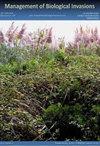威克环礁波利尼西亚大鼠(Rattus exulans)对溴代香菇丸和软饵袋的相对接受度
IF 1.2
4区 环境科学与生态学
Q3 BIODIVERSITY CONSERVATION
引用次数: 2
摘要
使用灭鼠剂清除岛屿生态系统中的入侵大鼠已被证明具有保护效益,是保护和恢复岛屿生态系统的重要管理工具。然而,如果不是所有的老鼠都摄入足够的诱饵导致致命的中毒,以灭鼠剂为基础的根除可能会失败。最近对在威克环礁消灭老鼠的失败尝试进行的一项术后审查表明,一些个体可能没有摄入致死剂量的灭鼠剂,这是由于通过定期获取人为食物来源而形成的潜在饮食和/或感官偏好。这些食物来源可能含有较高的脂肪和油,具有不同的感官特性(例如,更软、更有嚼劲等),而不是在消灭尝试中使用的灭鼠剂Brodifacoum 25W Conservation (B-25W)的较硬颗粒配方。为了验证这一理论,我们从威克岛的两个地区捕获了老鼠,在那里它们可能经常接触到人类的食物来源,以及岛上一个无人居住的地区,老鼠可能很少接触到人类的食物来源,因此不太可能预先适应这些食物类型。我们对它们进行了一项头对头的两种选择的诱饵选择试验,一种是“软”香囊配方的含Lumitrack®的FINAL软诱饵,另一种是较硬的B-25W颗粒配方。无论在哪个栖息地捕获老鼠,老鼠绝大多数更喜欢颗粒配方。在头对头的实验中,没有老鼠吃了最后一种诱饵,吃了B-25W的老鼠100%死亡。在另一组只吃FINAL诱饵的无选择实验中,有5只老鼠没有吃任何诱饵;在吃了最后一种诱饵的老鼠中,80%的老鼠死亡。我们的研究结果表明,威克环礁上的波利尼西亚大鼠不喜欢这种软配方的含溴灭鼠剂诱饵。我们的研究结果表明,在环礁居住地区的诱饵策略,为拟议的根除尝试,应继续侧重于利用传统的颗粒配方。虽然这些结果在我们的测试案例中是明确的,但我们建议在推断其他情况时要谨慎,因为当地啮齿动物种群的饮食偏好可能不同,当地环境条件可能使其他诱饵选择更合适和有效。本文章由计算机程序翻译,如有差异,请以英文原文为准。
Relative acceptance of brodifacoum pellets and soft bait sachets by Polynesian rats (Rattus exulans) on Wake Atoll
Removing invasive rats from island ecosystems using rodenticides has proven conservation benefits and is an important management tool for conserving and restoring island ecosystems. However, rodenticide-based eradications can fail if not all rats consume enough bait to result in lethal toxicosis. A recent post-operational review of a failed attempt to eradicate rats from Wake Atoll suggested that some individuals may not have ingested a lethal dose of rodenticide due to potential dietary and/or sensory preferences developed via regular access to anthropogenic food sources. These food sources may be higher in fats and oils, possessing different sensory properties (e.g., softer, chewier, etc.) than the harder pellet formulation of the rodenticide Brodifacoum 25W Conservation (B-25W) used in the eradication attempt. To test this theory, we captured rats from two areas on Wake Island where they may have regular access to human food sources, as well as an uninhabited part of island where rats presumably have less access to human-based food sources and therefore are less likely to be preconditioned for these food types. We subjected them to a head-to-head two-choice bait selection trial between a “soft” sachet formulation of a brodifacoum-based bait, FINAL Soft Bait with Lumitrack ® (FINAL), versus the harder pellet formulation of B-25W. Regardless of which habitat rats were captured in, rats overwhelmingly preferred the pellet formulation. No rats in the head-to-head trail consumed any of the FINAL bait, and 100% of the rats that consumed B-25W died. Of the rats in a separate no-choice trail of just FINAL bait, 5 failed to eat any bait; of the rats that did consume some of the FINAL bait, 80% died. Our results demonstrate that Polynesian rats on Wake Atoll do not prefer this soft formulation of brodifacoum-based rodenticide bait. Our results suggest that baiting strategies in the inhabited regions of the atoll, for a proposed eradication attempt, should continue to focus on utilizing traditional pellet formulations. While these results are unequivocal in our test case, we suggest caution in making inference to other situations where dietary preferences of local rodent populations may differ, and local environmental conditions may make other baiting choices more appropriate and efficacious.
求助全文
通过发布文献求助,成功后即可免费获取论文全文。
去求助
来源期刊

Management of Biological Invasions
Agricultural and Biological Sciences-Ecology, Evolution, Behavior and Systematics
CiteScore
3.40
自引率
6.70%
发文量
21
审稿时长
16 weeks
期刊介绍:
Management of Biological Invasions, established in 2010 by Dr. Elias Dana, is an open access, peer-reviewed international journal focusing on applied research in biological invasions in aquatic and terrestrial ecosystems from around the world. This journal is devoted to bridging the gap between scientific research and the use of science in decision-making, regulation and management in the area of invasive species introduction and biodiversity conservation.
Managing biological invasions is a crisis science, with Management of Biological Invasions aiming to provide insights to the issues, to document new forms of detection, measurements and analysis, and to document tangible solutions to this problem.
In addition to original research on applied issues, Management of Biological Invasions publishes technical reports on new management technologies of invasive species and also the proceedings of relevant international meetings. As a platform to encourage informed discussion on matters of national and international importance, we publish viewpoint papers that highlight emerging issues, showcase initiatives, and present opinions of leading researchers.
 求助内容:
求助内容: 应助结果提醒方式:
应助结果提醒方式:


